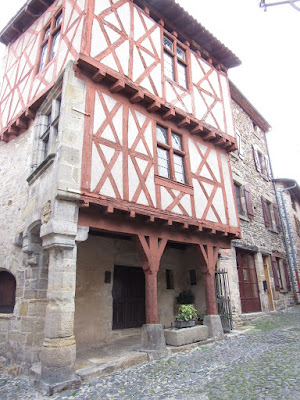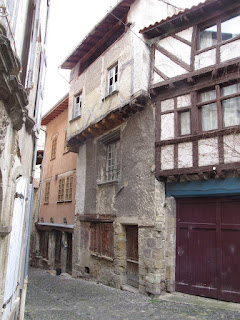
In 1669, when Fr. Medaille was ill and fragile, he was transferred to Billom where he lived in a senior care home for sick and elderly priests. He continued his ministry, however, by hearing confessions of the people in the town. He died on December 30, 1669, at the age of 59. Presumably he was buried in the cemetery next to the school but during the French Revolution, the cemetery was destroyed. There is no trace of Fr. Medaille's grave or remains, but the Jesuits do have a record of his death certificate.

Billom
is 120 kilometers northwest of Le Puy. Fr. Medaille, the
itinerant preacher, traversed the many miles of the Avergne region on
horseback.
Fr. Medaille was known to live his life of mission with such a reputation of holiness that people often called him a saint. He was also known to be appreciated by the wealthy, the poor, and the bishops in dioceses where he worked.
Click here for a video review of his life.
 The
open space next to the school may have been the site of the cemetery
where Fr. Medaille was buried. The feeling of being there was desolate
and a little sad, perhaps as a result of its history. Places sometimes
retain sentiments of their past.
The
open space next to the school may have been the site of the cemetery
where Fr. Medaille was buried. The feeling of being there was desolate
and a little sad, perhaps as a result of its history. Places sometimes
retain sentiments of their past.
 The
Jesuits operated a school in Billom. In 1764, during the
expulsion of Jesuits in France, the school was abandoned. From 1886-1963
the
school became a military prep school for young people. Today, the
building
stands empty with some painted windows that look like a school project
attempting to beautify the building. A newer lycée (high school) was
built
across the courtyard from the old building.
The
Jesuits operated a school in Billom. In 1764, during the
expulsion of Jesuits in France, the school was abandoned. From 1886-1963
the
school became a military prep school for young people. Today, the
building
stands empty with some painted windows that look like a school project
attempting to beautify the building. A newer lycée (high school) was
built
across the courtyard from the old building.

Remnants from another time, a crest of a lion with a sword is displayed at the entrance to the school campus.
The Medieval Town of Billom
Fr. Medaille would have been familiar with the old town of Billom that had been built in the Middle Ages. The narrow cobblestone streets, half-timbered buildings, sculpted doorways, and public squares are a common sight in French Medieval towns. People still reside in these towns although their buildings have been significantly updated with modern conveniences.
The Angaud River runs through Billom.
Interesting stone portals of houses.
Stone
sculptures rest high above the street. Many were used as directional
street signs for the people who lived in the town and were vastly
illiterate. They oriented themselves on the street by turning to the
left or right of a sculpture.
The
people washed their clothes in a river or in a fountain like
this one. Small towns in the Auvergne region typically have such
fountains.
Troughs
provided water for the horses. Today, they stand as decorative vessels
on their own or with flowers planted inside of them. It is interesting that a commonly-used utility sports such intricate carvings.
This half-timbered house was the former home of a prominent, rich family as indicated by the crest (see close-up below) etched onto the center of the house. The juxtaposition of this medieval house with modern cars is striking.

Here is another crest over the door of a home.


Signs outside doorways used to indicate artisanal shops. Today, they are more decorative, but just as engaging.


Narrow
cobblestone streets make-up the intricate, winding network of the town. Many
streets have been adapted to accommodate cars while others continue to
be pedestrian pathways.
A variety of houses adjacent to each other line the town's streets.




City squares were gathering places for markets, festivals, and milling about. A tower gives the town some height and prestige. This one has a clock attached to it.
The Jesuit Expulsion
The Jesuit movement was founded by Ignatius de Loyola in August 1534. Under his charismatic leadership, the Society of Jesus grew quickly. The Jesuits’ ministries in education and charitable works spread all over the world during Ignatius’ lifetime, and eventually to the new European colonies in the Americas in the 17th century. The Jesuits played an important role in the Counter-Reformation in Europe and won back many people who had been lost to Protestantism. They also succeeded in converting millions of people around the world to Catholicism.
However, with the rise of nationalism in the 18th century the European monarchs felt threatened by the religious order. They began to suppress the Jesuits in what is known as the “Jesuit expulsion” from the Portuguese Empire (1759), France (1764), the Two Sicilies, Malta, Parma, the Spanish Empire (1767) and Austria and Hungary (1782). These moves were ultimately, albeit reluctantly, approved by The Holy See in 1773.
The Jesuit suppression was largely political in nature. As part of their mission and purpose, the Jesuits were closely aligned with the papacy as protectors, however, they were considered too autonomous for the monarchs who were trying to centralize and secularize their political power. Some historians also view the suppression as motivated by economics because by the mid-18th century, the Jesuits had acquired a reputation in Europe for their monetary successes. Monarchs in many European states saw the Jesuits as foreign entities encroaching upon their sovereignty.
In 1814, Pope Pius VII restored the Society of Jesus to its previous provinces, and Jesuits resumed their ministries in those countries.





















No comments:
Post a Comment